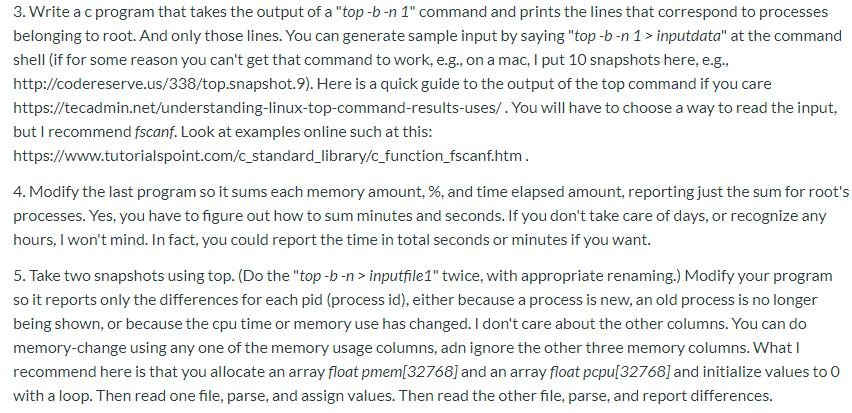Answered step by step
Verified Expert Solution
Question
1 Approved Answer
Please answer in C! 3. Write a c program that takes the output of a top-b-n 1 command and prints the lines that correspond to

Please answer in C!
3. Write a c program that takes the output of a "top-b-n 1" command and prints the lines that correspond to processes belonging to root. And only those lines. You can generate sample input by saying "top-b-n 1 > inputdata" at the command shell (if for some reason you can't get that command to work, e.g., on a mac, I put 10 snapshots here, e.g., http://codereserve.us/338/top.snapshot.9). Here is a quick guide to the output of the top command if you care https://tecadmin.net/understanding-linux-top-command-results-uses/ . You will have to choose a way to read the input, but I recommend fscanf. Look at examples online such at this: https://www.tutorialspoint.com/c_standard_library/c_function_fscanf.htm. 4. Modify the last program so it sums each memory amount, %, and time elapsed amount, reporting just the sum for root's processes. Yes, you have to figure out how to sum minutes and seconds. If you don't take care of days, or recognize any hours, I won't mind. In fact, you could report the time in total seconds or minutes if you want. 5. Take two snapshots using top. (Do the "top-b-n> inputfile1" twice, with appropriate renaming.) Modify your program so it reports only the differences for each pid (process id), either because a process is new, an old process is no longer being shown, or because the cpu time or memory use has changed. I don't care about the other columns. You can do memory-change using any one of the memory usage columns, adn ignore the other three memory columns. What I recommend here is that you allocate an array float pmem[32768] and an array float popu[32768] and initialize values to 0 with a loop. Then read one file, parse, and assign values. Then read the other file, parse, and report differences. 3. Write a c program that takes the output of a "top-b-n 1" command and prints the lines that correspond to processes belonging to root. And only those lines. You can generate sample input by saying "top-b-n 1 > inputdata" at the command shell (if for some reason you can't get that command to work, e.g., on a mac, I put 10 snapshots here, e.g., http://codereserve.us/338/top.snapshot.9). Here is a quick guide to the output of the top command if you care https://tecadmin.net/understanding-linux-top-command-results-uses/ . You will have to choose a way to read the input, but I recommend fscanf. Look at examples online such at this: https://www.tutorialspoint.com/c_standard_library/c_function_fscanf.htm. 4. Modify the last program so it sums each memory amount, %, and time elapsed amount, reporting just the sum for root's processes. Yes, you have to figure out how to sum minutes and seconds. If you don't take care of days, or recognize any hours, I won't mind. In fact, you could report the time in total seconds or minutes if you want. 5. Take two snapshots using top. (Do the "top-b-n> inputfile1" twice, with appropriate renaming.) Modify your program so it reports only the differences for each pid (process id), either because a process is new, an old process is no longer being shown, or because the cpu time or memory use has changed. I don't care about the other columns. You can do memory-change using any one of the memory usage columns, adn ignore the other three memory columns. What I recommend here is that you allocate an array float pmem[32768] and an array float popu[32768] and initialize values to 0 with a loop. Then read one file, parse, and assign values. Then read the other file, parse, and report differencesStep by Step Solution
There are 3 Steps involved in it
Step: 1

Get Instant Access to Expert-Tailored Solutions
See step-by-step solutions with expert insights and AI powered tools for academic success
Step: 2

Step: 3

Ace Your Homework with AI
Get the answers you need in no time with our AI-driven, step-by-step assistance
Get Started


